The state of Kentucky is well-known for its rolling hills, majestic lakes and abundant forests. But it’s also home to an array of mushrooms that can be found in these lush environs.
From the edible varieties to the inedible ones, there is a wealth of fascinating fungi to explore in the state. If you’re looking for an interesting outdoor activity that combines science and nature, hunting for mushrooms in Kentucky may be right up your alley.
List of Edible Mushrooms of Kentucky
It is important to be cautious when identifying and consuming wild mushrooms, as some species can be poisonous. If you are unsure whether a mushroom is safe to eat, it is best to err on the side of caution and not consume it.
1. Honey mushrooms
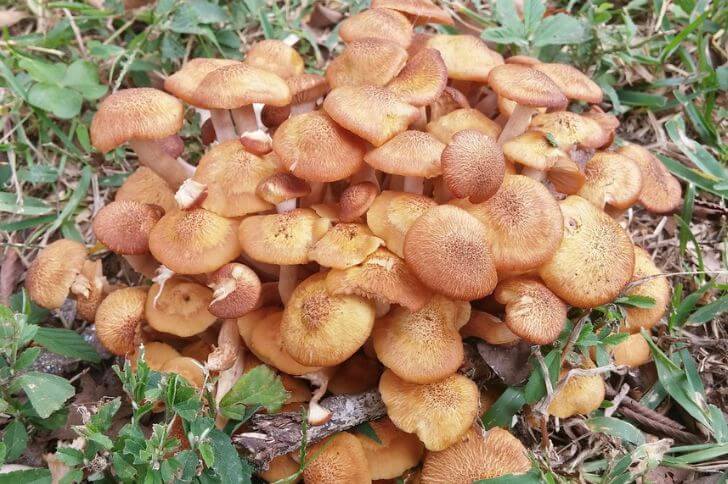
Honey mushrooms (Armillaria species) are an edible mushroom of KY. They are parasitic, preferring conifer trees.
You can find them on the base of these trees and are notoriously hard to get rid of. Identifying them since some mushrooms like pholiotas have a close resemblance. So what makes honeys honeys?
Identification:
There are three distinctive features that’ll help you identify honey mushrooms of Kentucky. One, look for rings around their stalks. This is an important marker. Two, cut one mushroom, flip it over and study its gills.
The gills of honey mushrooms are decurrent; they run from the end of the canonical caps to the top of the brownish stalk.
The third most important feature to look for when identifying honeys are their spore print. Honeys have white spore print.
Other important features to look for include their yellow-brown color. They generally grow in clusters.
2. Dryad’s Saddle
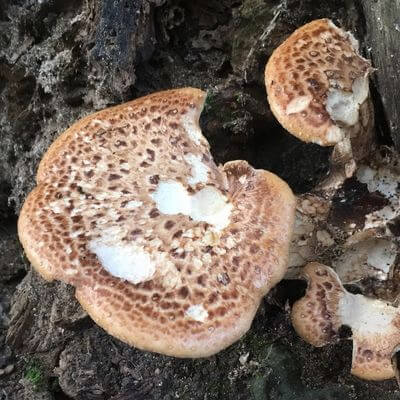
Dryad’s saddle mushrooms are another type of wild edible mushroom of Kentucky. Also known as Polyporus squamosus or the pheasant back mushroom, they occur on the sides and trunks of trees and like honey mushrooms above, they cause white rot on their hosts.
Identification:
You will want to harvest young dryad’s saddles only. I’ve found mature fungi are hard to clean; no one wants to clean out maggots. Young pheasant back mushrooms are distinguished by their large cream fan-shaped cap which has darker scales.
They are about 2-4 inches wide. Mature fruiting bodies can grow to 12 inches across. The underside of the cap is white with many small pores. Its spore print is whitish for younger species and turns yellowish-tan for older species. Also their strong watermelon scent makes identification easy.
I think it’s an easily identifiable bracket fungus since it doesn’t have many look-alikes. When can you find dryad’s saddle in Kentucky? You can find them from April through August. I like them for their mealy taste.
3. Meadow Waxcap
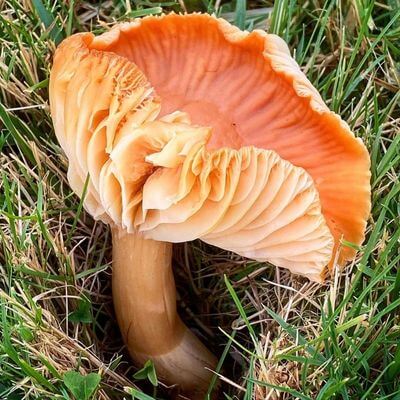
Waxcap mushrooms are some of the most unique and diverse fungi out there. Most of them are inedible, however a few subspecies in this family such as the meadow waxcap are edible.
Identification:
You want to be 100% sure what you are picking and placing on your place are meadow waxcaps.
When foraging, be on the look for 6-inch tall mushrooms that have pale orange convex caps. The orange hue resembles salmon flesh which gives them their alternative name salmon waxcaps.
Their convex caps eventually flatten out as they mature but you want to go for younger mushrooms with convex caps; they are tastier. Flip the cap and examine the decurrent gills. They produce a white spore print and are widely spaced.
Where can you find them? They are common yard mushrooms in Kentucky. You can also find them in fields and roadsides. Can you eat meadow waxcaps? Yes.
4. Morel Mushrooms in Kentucky
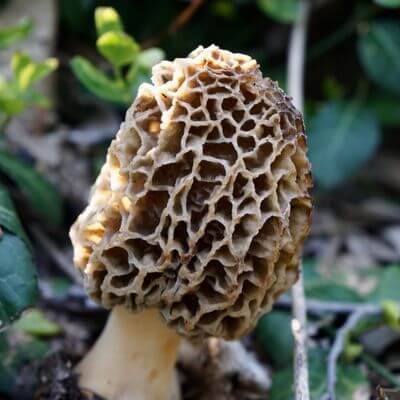
Every spring, Kentuckians embark on morel mushroom hunts throughout the state. Morels are easy to spot due to their distinct appearance.
Identification:
Where can you find Kentucky morels? They can be found growing near hardwood trees such as elms and ash trees but can also be found under dead leaves.
Foraging for them requires patience and an experienced eye since these mushrooms can often blend into their surroundings making them difficult to find.
These delicious fungi have a honeycomb patterned cap with ridges and pits on the surface.
The walls of the mushroom inside are hollow from top to bottom, making it easy to spot its distinguishing feature when cut open.
Additionally, morels range from light tan to brownish-gray in color depending on age and variety. It’s important to note that some false morels may look similar but can be identified by their solid walls instead of being hollow inside.
5. Chanterelles

Are there chanterelles in Kentucky? Yes, this wild edible mushroom is found in abundance in KY.
Chanterelles mushrooms are a culinary delight and are popular for their delicate flavor and distinctive shape.
Identifying them correctly is essential for any mushroom hunter, as many other species may look similar but could be inedible.
Identification:
Chanterelle mushrooms have a few defining characteristics that help to differentiate them from other wild mushrooms.
First, they have a bright yellow-orange color with a funnel shaped cap that is often lobed along the edges.
Secondly, they have an apricot-like scent which helps to distinguish them from false look-alikes in the field.Thirlby, unlike most mushrooms this yellow mushroom of Kentucky has false gills.
They look alike, false chanterelles, have an orange-brown cap and do not smell like apricots.
Related Read: Common mushrooms of Alabama
6. Lion’s Mane
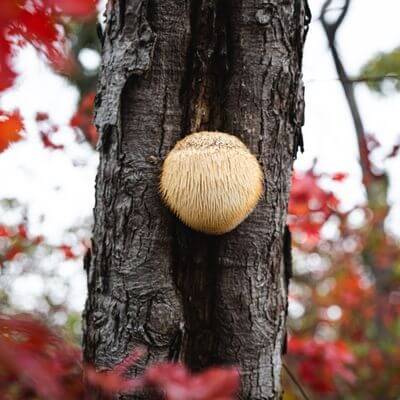
Lion’s mane mushrooms are an edible fungi found in the wild, typically growing on hardwood trees. Also known as mushrooms, it’s one of the most recommended mushrooms in the tooth fungi family.
Identification:
Known for their unique appearance, these mushrooms can be identified by their white cascading spines that resemble a lion’s mane.
The fruiting bodies grow up to 15 inches in diameter but like most mushrooms on this list, we recommend you go for younger mushrooms about 2-5 inches wide.
In addition to its distinctive look, the mushroom also has a distinct taste similar to seafood or crab meat.
Lion’s mane start popping out from late summer through fall. What trees do they grow on?
They prefer dead trees, helping in decomposition. Occasionally, you may find them growing on live beech trees. Unfortunately, their infestation causes the tree to yield empty husks or less tasty nuts.
7. Yellowfoot Mushrooms
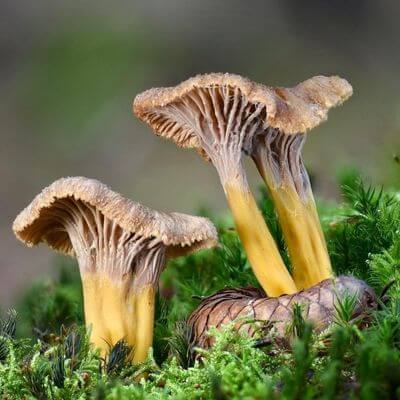
What are the winter mushrooms in Kentucky? Yellowfoot mushrooms. Also known as winter mushrooms or tubies, they grow starting in the late summer, often near swampy forested areas or decaying hardwood.
Identification:
From afar, they look like other chanterelles. Upon close examination, you’ll notice they have a small cap that is roughly 1-2 inches wide and yellowish brown.
The stem is usually thin and bright yellow. Cut in half, the stem is hollow. Also note, like other chanterelles they have no gills.
Where can you find yellowfoot mushrooms? They grow individually on decomposing logs or buried stumps.
And because they are smaller than other types of chanterelles, you’ll need to harvest a lot of them. Cooking yellowfoot mushrooms is easy. Just saute with garlic and onion. They are also great pizza toppings.
8. Common Bonnet Mushroom
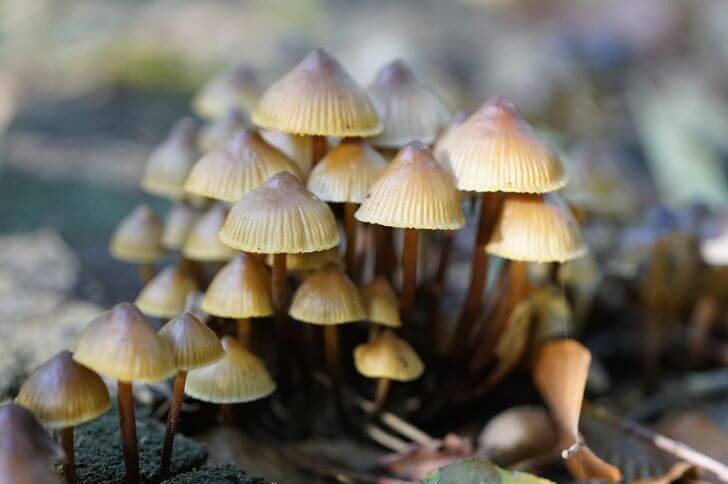
While there are hundreds of species of mushrooms in KY, one of the most common fungi is the bonnet mushroom. Identifying this type of mushroom is important to ensure it is safe for consumption.
Identification:
Bonnet mushrooms have a distinctive cap shape; they look like small umbrellas when viewed from above.
The top is typically grayish brown with a darker center. The underside has gills which may be white or gray and spaced tightly together.
This mushroom also has a white stem that is between 2-3.5 inches tall.
Are common bonnets edible? Yes they are. But I think the question here should be are they worth the hassle?
Honestly, I don’t think they are. They are smaller compared to most edible mushrooms of Kentucky. Plus, their flesh is thin with no distinctive taste.
9. Hedgehog Mushrooms
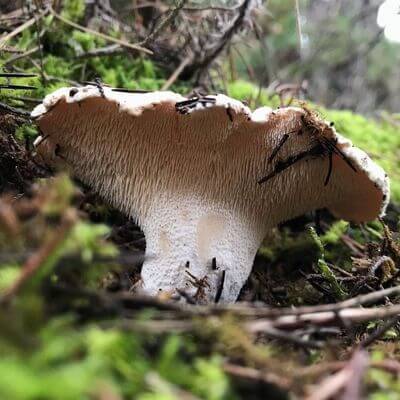
Hedgehog mushrooms is a name given to a species of fungi closely related to chanterelles. They are also as unique as the lion’s mane above, making identification easy.
Identification:
There are three foolproof ways I identify hedgehog mushrooms. One, when walking through the woods I look for a splash of orange or yellow. Young mushrooms have round smooth caps but older hedgehogs have irregular shaped caps.
Two, I identify this fungus by its white teeth-like growths located underneath the cap instead of gills. Their spore print is creamish. Three, they have a fruity odor. If you’ve come across golden chanterelles, it has a similar smell.
In addition to its unique appearance, hedgehog mushrooms have a pleasant earthy flavor when cooked which makes them popular among foragers and chefs alike.
They grow singly or fairy rings. You can find them in fall.
10. Mock Oyster Mushroom
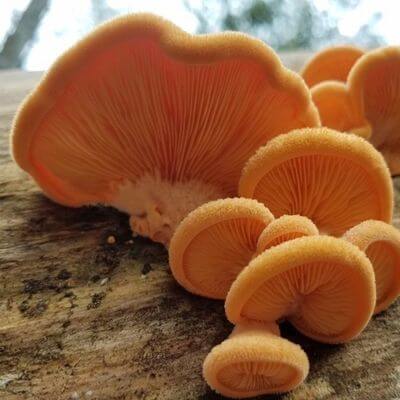
Mock oyster mushrooms are a popular edible mushroom variety that is also known as orange oyster.
Identification:
This Kentucky fungi can be identified by its fuzzy, delicate texture and fan-shaped caps. Mock oysters grow to 3.9 inches with inrolled margins. Their flesh is orange.
Another easy way to identify these oysters is by their smell? Horrid smell, I’d describe it as skunk-like. Mock oysters are edible but if like me you don’t want your kitchen to stink, avoid them. Stick to other oyster species.
These mushrooms are mainly found in temperate forests across the Northern Hemisphere and have an unmistakable flavor that is both sweet and nutty.
However, distinguishing between true oyster mushrooms and mock oyster mushrooms can be difficult for inexperienced mushroom hunters.
11. Oyster Mushrooms
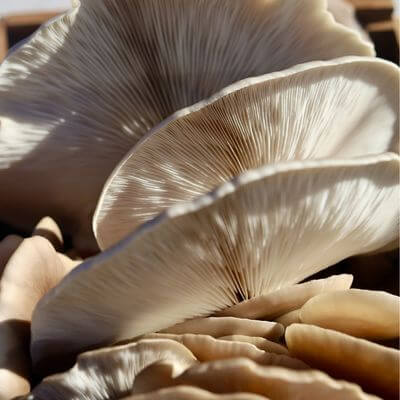
Oyster mushrooms are one of the most cultivated mushrooms in North America. In Kentucky, these edible white mushrooms can be found in the wild or cultivated.
If you are looking for mushrooms that are loved for their savory flavor and delicate texture, you can’t go wrong with oysters.
Identification:
Oyster mushrooms are easily identified by their fan-shaped caps with scalloped edges. They are typically white to gray and have white gills on the underside of the cap.
Additionally, oyster mushrooms tend to grow clustered together on dying trees, as well as soil enriched with wood chips or sawdust for cultivated species.
Foraged oysters need cleaning. Keep in mind they absorb water so don’t leave them soaked for too long. Once clean, you can grill, saute or stir-fry.
12. Pear-shaped Puffball
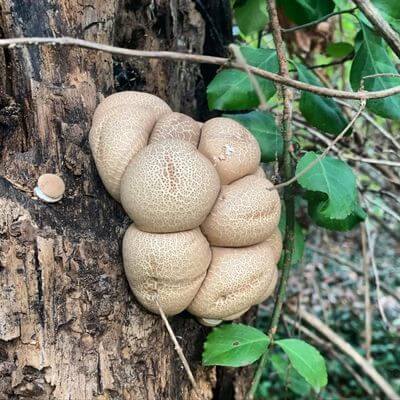
The pear-shaped puffball is an elusive mushroom of Kentucky that can be found growing on wood.
Identification:
With its unique shape and delicate texture, the pear-shaped puffball is a rare find for avid mushroom hunters. Despite its rarity, identifying this species of mushroom isn’t difficult.
When attempting to identify the pear-shaped puffball, be sure to look for a round or egg-like shape that tapers off at one end like a teardrop or a pear.
The color will range from white to yellowish brown, and it is often covered in small bumps or warts. Additionally, when cut open the inner flesh should be solid white.
13. Chicken of the Woods
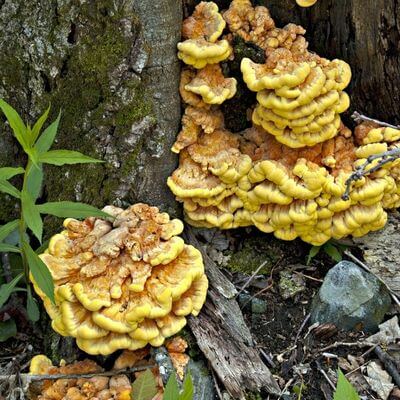
A lot of people in the Bluegrass State enjoy chicken of the woods from late August through September and may extend to October.
Note, unlike other edible Kentucky mushrooms, they are not dependent on rain and may appear in summer. Also known as sulphur shelf, they are the easiest to spot due to their massive cluster size and vibrant colors.
Identification:
Where can chicken of the woods be found? They are often found on dying trees or dead stumps. And yes, they reappear on the same spot every year until they’ve used up all the nutrients.
When scouring the woods, lookout for orange-yellow or orange-red fungi with slightly wrinkled surfaces.
The fan-shaped caps grow in overlapping clusters. Flip the fungi and you’ll see its pore-bearing surface. Chicken of the woods have false stalks. Its firm flesh is also orange-yellow.
14. Turkey-tail Mushrooms
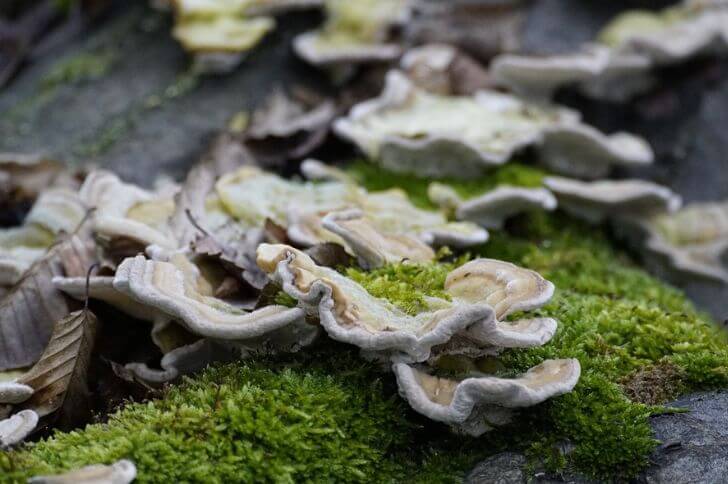
Turkey-tail fungus, scientifically known as Trametes versicolor, is one of the most recognizable fungi species in the world.
Identification:
Its distinctive fan shape and unique cap make it easy to identify. The turkey-tail mushroom cap ranges in color from buff to orange brown – hence its scientific name “versicolor” meaning “various colors”.
It typically grows a few inches wide with concentric circles that look like overlapping feathers of a wild turkey’s tail.
When can you find them? Due to their hardy nature, they are round all-year round in Kentucky. You can find them on dead hardwood stumps. This fungus has many benefits.
15. Velvet foot
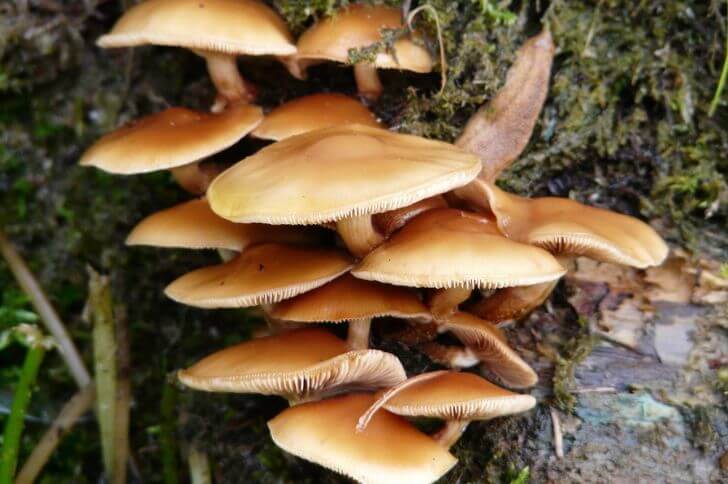
Closely related to the long enokikate mushrooms of Asia, the Velvet foot mushrooms, also called enoki, are an edible species of mushroom that occur naturally in Kentucky.
Identification:
These mushrooms have soft smooth caps with a distinctive yellow-orange coloration and are darker in the middle.
The stems are typically dark brown in color. Additionally, these mushrooms are loved for their sweet and meaty flavor.
Inedible Mushrooms in Kentucky
What are the mushrooms in KY that are inedible? The 4 below are common compared to other inedible fungi.
16. Violet-toothed Polypore
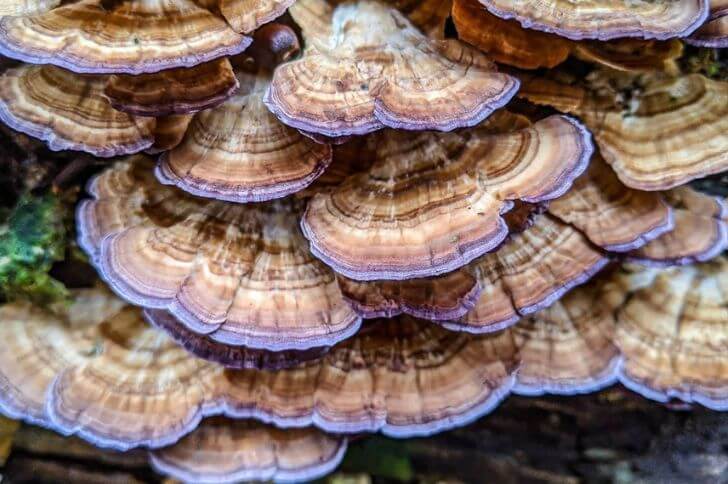
Are there invasive fungi of Kentucky? Yes, the Violet toothed polypore mushrooms fit the bill. They are members of the bracket fungi family.
Identification:
These mushrooms have a distinctive look and can easily be identified by mushroom foraging enthusiasts.
Violet toothed polypore can be identified by their striking, purple-colored capsThe semicircular cap grows up to 3 inches wide.
Unlike other bracket fungi, this tree mushroom has a hairy surface. Additionally, it has an underside with white pores that resemble teeth when viewed up close.
Are these bracket fungi edible? No, violet toothed polypore mushrooms are inedible. You can find them on dead wood.
17. Flower-pot Parasol
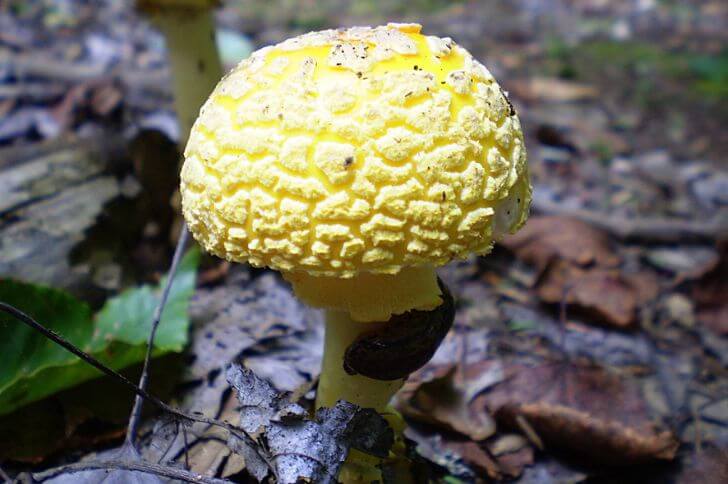
Leucocoprinus birnbaumii, popularly called flowerpot parasol mushroom, is a species of fungus commonly found in gardens or on indoor flower pots.
Identification:
The most obvious feature of Leucocoprinus birnbaumii is its vibrant yellow color. The bell-shaped cap can reach up to 3 inches wide with a thin edge that curls inward slightly.
Sulfur yellow gills can be seen underneath the cap and there may be some white scales on the stem’s surface which gives it a fuzzy appearance. This yellow mushroom grows in clusters often near decaying wood or mulch in shaded areas during warm summer months.
18. Fly Agaric
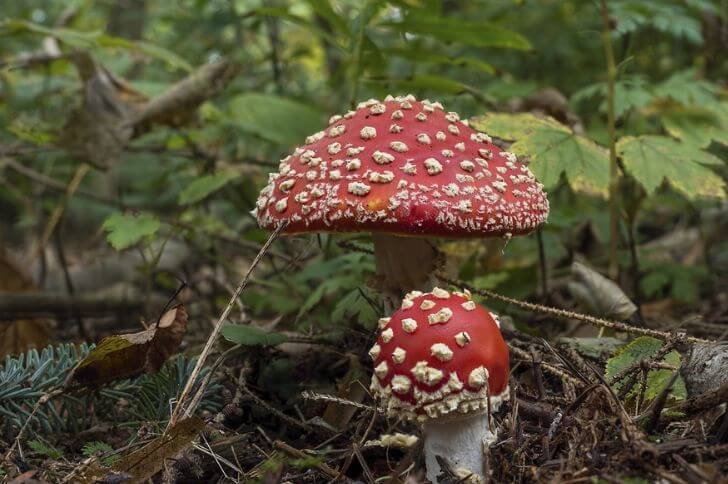
Fly agaric is one of the most recognizable and iconic mushrooms in North America as well as in the Bluegrass state.
Identification:
This red species is widely known for its striking red cap with white spots, which has made it a popular figure in many cultures’ folklore and mythology. Despite its beautiful appearance, however, fly agaric should not be consumed.
19. Jack-o-lantern Mushrooms
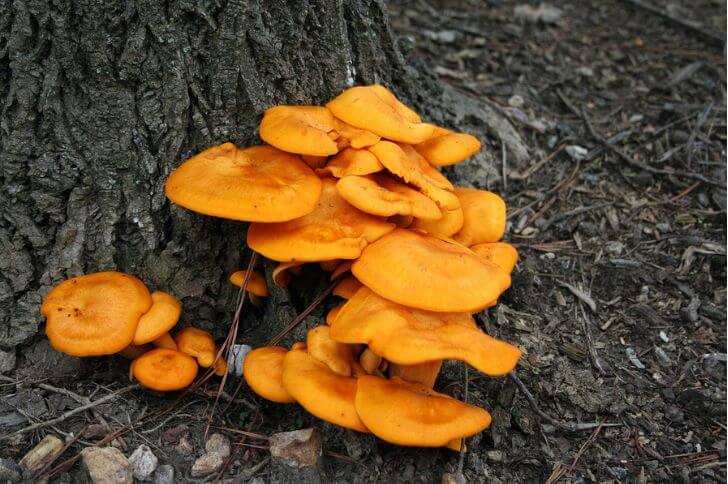
For those seeking to explore the outdoors this fall, one unique and exciting find can be the Jack-o-lantern Mushroom. They resemble chanterelles but a few key features will help you avoid them.
Identification:
This mushroom is easily identifiable due to its bright orange coloration which is similar to chanterelles but how can you tell them apart?
- Jack-o-lanterns always grow on dying trees or stumps while chanterelles pop from the ground.
- These mushrooms have gills which chanterelles don’t.
- Jack-o-lanterns are typically larger than chanterelles. One mushroom can fit your in your palm
FAQs
Do mushrooms grow in KY?
Yes, you can find both cultivated and wild mushrooms in the Bluegrass state. Most common mushrooms include morels, chanterelles, sulfur shelf fungus, and honey mushrooms.
What are the edible mushrooms in Kentucky?
Edible mushrooms of KY include morels, honey mushrooms, lion’s mane, hedgehog mushrooms and chanterelles.
Are there inedible mushrooms in KY
Common inedible mushrooms in the State of Kentucky are fly agaric, jack-o-lanterns, flower-pot parasols, destroying angels and false morels.
Can you find morels in Kentucky?
From April, after the first of the first showers, morels will pop out and within a few weeks grow to about 5 inches. Locally they are known as hickory chickens.
Final Thoughts
The Bluegrass State of Kentucky is home to an array of diverse wildlife, including a wide variety of edible mushrooms. With its humid and temperate climate, Kentucky has become a haven for mushroom hunters who are looking to take advantage of the large number of species that can be harvested from the state.If you are a beginner or seasoned forager, the above list of mushrooms will come in handy the next time you scour the woods or mountains.
Sources:
Hi There,
My name is Jenny. I’m the Chief Editor at Try Green Recipes and besides making yummy and healthy foods for my kids, grandkids, and friends. I’m new to the blogging world but I believe what I have to share is unique and will bring joy to your home. If you are adventurous and want try something tasty, let’s get started.

